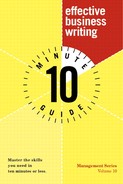0%
22Chapters
0-1Hours read
0kTotal Words
Book Description
If you have to write business letters, but have never been trained to write them, this book will teach you how. By following a number of simple steps, you will be able to create an effective business letter. You will learn how to lay out each section so that you communicate clearly. "Before" and "after" examples are included.
Table of Contents
- Copyright
- Introduction
- Conventions Used in This Book
- Acknowledgements
- The Authors
- 1. Effective Business Writing Matters
- 2. Start with a Purpose in Mind
- 3. Framing Your Thinking
- 4. The Opening Is the "Bottom Line"
- 5. Give Your Reader Sufficient Background
- 6. Making Your Recommendation or Conclusions
- 7. Providing Rationale for Your Recommendations
- 8. Add Information as Needed
- 9. Specify What Should Happen Next
- 10. Outline Your Thinking
- 11. Writing Business Letters
- 12. Writing E-Mail
- 13. Writing a Presentation Document
- 14. Avoid the Grammar Minefield
- 15. Style Facilitates Effective Communication
- A. Recommended Resources
- B. Glossary
